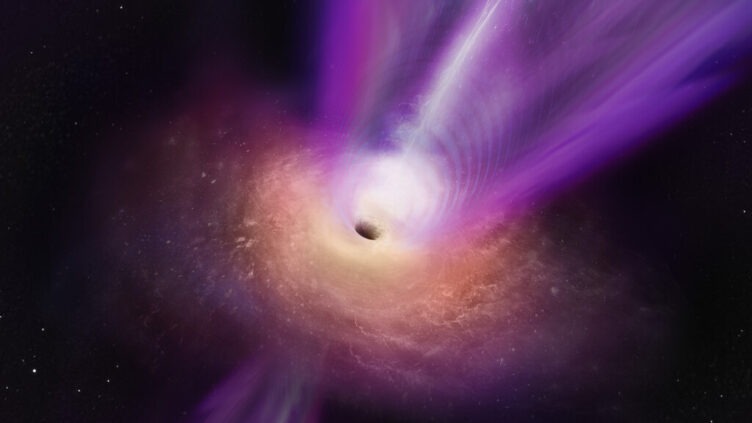Galaxies as far as the eye can see fill the images of the deep Universe. What processes determined their shapes, colors and star populations? Astronomers think that primordial black holes were the engines of the growth and transformation of galaxies, and that they can explain the cosmic landscape we see today.
In an article published in the scientific journal Astronomy & Astrophysics, an international team led by Rodrigo Carvajal, from the Institute of Astrophysics and Space Sciences (IA) and the Faculty of Sciences of the University of Lisbon (Ciências ULisboa), and which includes ten IA researchers, presents a machine learning method (machine learning) that recognizes superluminous galaxies in the early Universe.
These are galaxies thought to be dominated by the activity of a devouring central black hole. According to the authors, this will be the first algorithm that predicts when this activity also emits an intense signal at radio frequencies.
Radio emissions are, in general, distinct from the rest of the galaxy's light, and it is sometimes difficult to associate them. This artificial intelligence technique will allow astronomers to be more effective in searching for so-called radio galaxies.
The algorithm, developed in collaboration with the company Closer, which operates in the technological solutions sector in data science, was trained with images of galaxies in various wavelengths of light.
When tested with other images, it was shown to be able to predict four times more radio galaxies than conventional methods with explicit instructions. As machine learning develops its own algorithms, trying to understand its success can help shed light on the physical phenomena that were happening in these galaxies, 1,5 billion years after the Big Bang, that is, when the Universe was a tenth current age.
“We need to find more active galaxies in the sky, because there are predictions that there should have been many more at the beginning of the history of the Universe. With current observations we do not have that number”, says Rodrigo Carvajal. According to this researcher, more observations are needed to verify whether the current understanding of the evolution of active galaxies is correct or needs to be modified.
“It is also important to analyze the machine learning models themselves and understand what is happening within them”, adds Carvajal. “What are the most relevant properties for the decision? For example, we want to know whether the most important property for the model to have stated that it is an active galaxy is the light that the galaxy emits in the infrared, possibly indicative of a rapid formation of new stars. With this we were able to create a new law to distinguish between what is a normal galaxy and an active galaxy.”
The relative weight of the characteristics of galaxies in the decision made by the computer may point to what is at the origin of their intense activity, particularly in the radio band. In a study in preparation, Carvajal is exploring the implications of this apparent dependence between radio emission and star formation.
Israel Matute, from IA e Ciências ULisboa, and second author of the article, clarifies: “These models are mathematical tools that help us look in the right direction when the complexity of the data increases. This work may provide clues to the processes that held back the formation of new stars in the second half of the history of the Universe.”
Perhaps the active galaxies apparently missing from the early Universe will be found in the millions of data points that modern radio telescopes will produce in the coming years. Future surveys of large regions of the sky will reveal billions of galaxies. An example is the Evolutionary Map of the Universe (EMU), which will map the entire southern celestial hemisphere with the ASKAP radio telescope in Australia.
The team led by IA is already working with data from a pilot project of this screening. Once perfected, these tools will be crucial to processing the astronomical amount of data that the future observatory Square Kilometer Array (SKAO) will produce. Portugal is a member of the consortium for this observatory, which is already under construction.
“At a time when astronomy will access vast amounts of data, it is increasingly important to develop advanced techniques for its processing and analysis”, says José Afonso, from IA e Ciências ULisboa and co-author of the article. “At IA we are developing and implementing these techniques, to be able to decipher the origin of galaxies and the supermassive black holes that many host.”
The idea for the company Closer to collaborate with IA came from co-author of the article Helena Cruz, a PhD in Physics and data scientist at this company. Her involvement was essential to analyze and address the impacts of uncertainties and inconsistencies between the different data – coming from various telescopes and observation plans – used in training the machine learning algorithm.
“I realized that astronomy is an area with great opportunities for exploration and development of astronomy models. machine learning, and it made sense for me to apply my professional knowledge to this area”, says Helena Cruz. “I shared this interest with Closer and both parties immediately showed desire for this collaboration, which I see as a continuation of my work at the company.”
“Closer lives off the knowledge of its employees, that is its capital”, adds João Pires da Cruz, co-founder of Closer, professor and researcher.
“The more challenging and sophisticated from a scientific point of view the projects in which our employees are involved, the greater the company's capital will be. We will have employees capable of solving problems for our customers that are similar to the signal problem from distant galaxies.”




















Comments